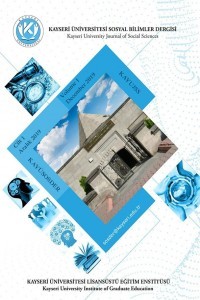TR72 bölgesinde il düzeyinde inşaat-sanayi ve hizmetler sektörü yığılmasının lokasyon katsayısı yöntemiyle araştırılması
Yığılma, firmaların ve benzer sektörlerin belli bir coğrafyada bir araya gelerek yoğunlaşmasıdır. Sektörel yığılma ulaşılabilirlik, maliyetten tasarruf, yerel firmalar için yarışma avantajları sunmaktadır. Sektörel yığılma aynı zamanda kent ekonomisi için önemli avantaj sağlamaktadır. Çalışmada TR72 Bölgesini oluşturan Kayseri, Sivas ve Yozgat illerinde inşaat, sanayi ve hizmetler sektörlerinde yığılma düzeylerinin ve hangi ilde hangi sektörün baskın olduğunun araştırılması amaçlanmıştır. Çalışmada Sosyal Güvenlik Kurumu’nun il bazında yıllık sigortalı çalışan sayıları esas alınmıştır. Çalışmada yığılma düzeyinin tespitinde lokasyon katsayısı (LQ) yöntemi kullanılmıştır. Sonuçta Kayseri’de yarışabilecek seviyede sanayi sektörü yığılması; Sivas ve Yozgat illerinde inşaat ve hizmetler sektörü yığılmasının bulunduğu belirlenmiştir. İleride yapılacak olan planların sektörel tahmin ve projeksiyonlarında Kayseri'de sanayi kararlarında yığılmış işgücü varlığı, Sivas’ta inşaat sektörü yığılma düzeyinde azalma eğilimine, Yozgat’ta inşaat ve hizmetler sektörü yığılmasında artış olması hususlarına dikkat edilmesi gerektiği sonucuna ulaşılmıştır.
Anahtar Kelimeler:
Kent Ekonomisi, Sektörel Yığılma, İnşaat-Sanayi-Hizmet Sektörleri, TR72
Investigation of the construction-industry and service sectors agglomeration at provincial level in TR72 region by location quotient method
Agglomeration is concentration of companies and similar sectors in certain geography. Agglomeration offers accessibility, cost savings, competition advantages for local companies. Agglomeration also provides an important advantage for the urban economy. In this study, it is aimed to investigate the agglomeration levels in the construction, industry and services sectors in Kayseri, Sivas and Yozgat provinces that they constitute the TR72 Region, and which sector is dominant in which province. In the research, the annual number of insured employees of the Social Security Institution on a provincial basis had been utilized. In this work, the location quotient (LQ) method was used to determine the level of agglomeration. As a result, it has been determined that there is a construction and services sectoral agglomeration in Sivas and Yozgat provinces. In the sectoral estimates and projections of future plans, it was concluded that industrial decisions should be taken into consideration in the existence of specialized workforce in Kayseri, the level of construction sector agglomeration in Sivas, and increasing tendency in the construction and services sector agglomeration in Yozgat.
___
- Akgüngör, S. (2006). Geographic concentrations in Turkey's manufacturing industry: Identifying regional highpoint clusters. European Planning Studies, 14(2), 169-197. https://doi.org/10.1080/09654310500418002
- Bottazzi, G., & Gragnolati, U. (2015). Cities and clusters: economy- wide and sector-specific effects in corporate location. Regional Studies, 49(1), 113-129. https://doi.org/10.1080/00343404 .2012.739281
- Crawley, A., Beynon, M. & Munday, M. (2013). Making location quotients more relevant as a policy aid in regional spatial analysis. Urban Studies, 50(9), 1854-1869.
- Cromley, R.G., & Hanink, D.M. (2012). Focal location quotients: Specification and applications. Geographical Analysis, 44(4), 398-410.
- Çiftçi, M. (2018). Türkiye’ de bölgelerarası sektörel verimliliğim analizi. İşletme Araştırmalar Dergisi, 10(1), 551 – 580. https://doi.org/10.20491/isarder.2018.407
- Demirdöğen, S. (2018). Kümelenme potansiyeli gösteren sektörlerin belirlenmesi: TRA 1 Düzey 2 Bölgesi üzerine bir uygulama. Bolu Abant İzzet Baysal Üniversitesi Sosyal Bilimler Enstitüsü Dergisi, 18 (4) , 85-113 . https://doi.org/10.11616/asbed.v18i41997.505856
- Dîrzu, M. (2012). A conceptual approach to economic agglomerations. Center for European Studies, 4 (3), 316-322.
- DPT. (2002). Sekizinci beş yıllık kalkınma planı yerel yönetimler özel ihtisas komisyonu raporu, DPT Yayınları.
- Gibson, J., Miller, M., & Wright, G. (1991). Location quotient: a basic tool for economic development analysis. Economic Development Review, 9(2), 65–68.
- Glaeser, E.L., Kallal, H.D., Scheinkman, J.A., & Shleifer, A. (1992). Growth in cities. Journal of Political Economy, 100(6), 1126–1152.
- Henderson, J.V. (2003). Marshall’s scale economies. Journal of Urban Economics, 53(1), 1–28.
- Isserman, A.M. (1977). The location quotient approach to estimating regional economic impacts. Journal of the American Institute of Planners, 43(1), 33-41.
- Karakayacı, Ö. (2010). Ekonomik büyüme ve girişimcilik aktivitelerinde kümeleşmenin rolü: Bursa ve Konya sanayi kümeleri örneğinde karşılaştırmalı bir araştırma. Megaron, 5(3), 149-159.
- Leigh, L. (1970). The use of location quotients in urban economic base studies. Land Economics, 46(2), 202-205.
- Meyer, J.R. (1963). Regional economics: A survey. American Economic Review, 53, 1–54.
- Moineddin, R., Beyene, J., & Boyle, E. (2003). On the location quotient confidence interval. Geographical Analysis, 35(3), 249-256.
- Munandar, T.B., Azhari, Musdholifah A., & Arsyad, L. (2017). Modified agglomerative clustering with location quotient for identification of regional potential sector. Journal of Theoretical and Applied Information Technology, 95(5), 1191-1199.
- Nayyar, G. (2011). The quality of employment in India's services sector: exploring the heterogeneity. Applied Economics, 44(36), 4701-4719. https://doi.org/10.1080/00036846.2011.589816
- Pan, F., Hall, S., & Zhang, H. (2020). The spatial dynamics of financial activities in Beijing: agglomeration economies and urban planning. Urban Geography, 41(6), 849-864. https://doi.org/10.1080/02723638.2019.1700071 Parr, J.B. (2014). The regional economy, spatial structure and regional urban systems. Regional Studies, 48(12), 1926-1938. https://doi.org/10.1080/00343404.2013.799759
- Porter, M. (1998). Clusters and new economics of competition. Harvard Business Review, 76(6), 77-90.
- Porter, M.E. (2000). Location, competition, and economic development: Local clusters in a global economy. Economic Development Quarterly, 14(1), 15-34.
- Potter, A., & Watts, H.D. (2014). Revisiting Marshall's agglomeration economies: Technological relatedness and the evolution of the sheffield metals cluster. Regional Studies, 48(4), 603-623. https://doi.org/10.1080/00343404.2012.667560
- Şahin, T.M, & Türkoğlu, T. (2017). Türkiye’ de mobilya imalat sanayinin mekânsal kümelenme örüntüsü: 2003-2014 yılı karşılaştırmalı lokasyon katsayısı analizi. B. Ayhan, M. Ay, S. Avşaroğlu & Ş. Akpınar (Ed.) içinde, Sosyal Bilimler ve Beşeri Bilimler Araştırmaları (ss. 428-436), Çizgi Kitapevi.
- Seçkin, E. (2015). Perakende sektöründeki yapısal dönüşümün Bursa’daki üretim piyasası ile tüketim piyasasına yansıması. Megaron, 10(1), 70-79.
- Taştekin, A. (2018). Türkiye’de bölgesel kalkınma stratejileri ve bölge idareleri. Uluslararası Yönetim Akademisi Dergisi, 1(1), 69-83.
- Tian, Z. (2013). Measuring agglomeration using the standardized location quotient with a Bootstrap Method. The Journal of Regional Analysis and Policy, 43(2), 186-197.
- ISSN: 2687-5772
- Yayın Aralığı: Yılda 2 Sayı
- Başlangıç: 2019
- Yayıncı: Kayseri Üniversitesi
